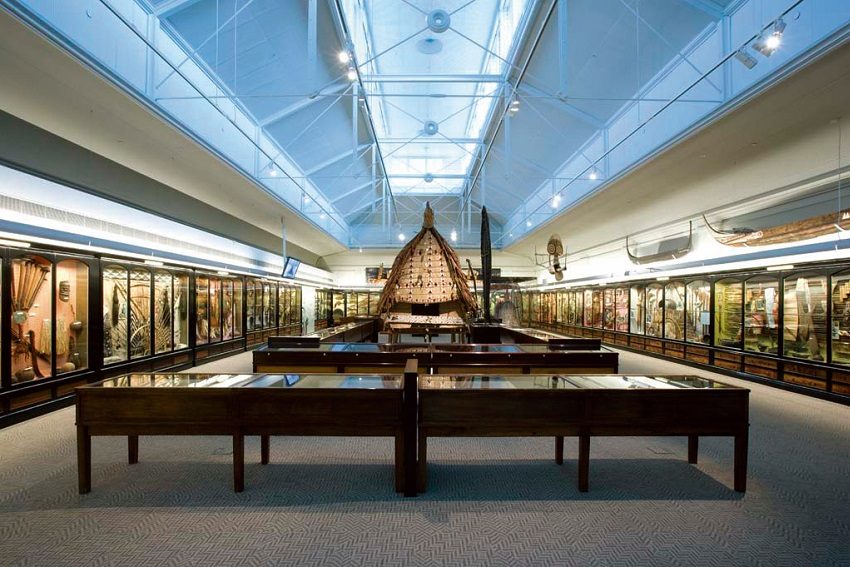World cultures and the Western Pacific at the South Australian Museum

The South Australian Museum recently signalled an important shift in its approach to human creativity and endeavour, renaming its ‘Foreign Ethnography Collection’ as the ‘World Cultures Collection’.
Turning away from the colonial notion that a museum looks at human cultures through an ethnographic lens, the South Australian Museum now aims to think about human cultures as part of a global ecology in which we all participate.
The World Cultures Collection consists of over 22,000 objects. This includes material from Africa, Asia, Europe and the Americas, but the 17,000 items from the Pacific comprises the largest and most important aspect of the Museum’s World Cultures Collection, and a substantial percentage of these items are kept on permanent display.
Since starting my World Cultures Fellowship at the South Australian Museum in March, I’ve made a practice of walking through the Pacific Gallery almost every day. With around 3000 objects on exhibit, it is reputed to be one of the most expansive displays of Pacific material to be found anywhere in the world. This reputation is well deserved. I’m endlessly fascinated by the richness of detail and the rare treasures that the Pacific Gallery contains. And I’ll continue to make it part of my daily routine because every visit rewards me with new surprises and insights.
The South Australian Museum’s Pacific Gallery is also remarkable for the way that it captures a distinctly Australian perspective on the Pacific region.

For many people, ‘The Pacific’ is a foggy geographical concept. It describes an expanse of ocean that covers almost a third of the planet’s surface area; a watery realm sparsely populated by culturally diverse groups of people. It’s a geographic generalisation, to say the least. In some respects it makes more sense to think of the Pacific as a purely imaginary place; a geo-political screen onto which partial histories and possible futures have been projected from different points of the globe.
From a North American perspective, for example, the Pacific tends to refer to Hawaii and the Micronesian territories north of the equator, across which the United States’ political relationships with Japan, Vietnam, Korea and China have been played out. For New Zealanders, the Pacific is primarily about the clusters of Polynesian islands that stepped out paths of migration to Aotearoa some 700 years ago, and which continue to share close cultural links with the contemporary Pacific Islander communities that have resettled in New Zealand. From a European perspective, the Pacific is the oceanic flipside of the planet; a vast antipodean realm that includes the islands of Australia and New Zealand.
Australia’s perspective on the Pacific, however, has always primarily focused on the western Pacific; on the Melanesian cultures of New Caledonia, Fiji, Vanuatu, Solomon Islands, Bougainville, Papua New Guinea, and West Papua. It is in this zone of the western Pacific that Australia has exercised governance, ‘recruited’ labourers, fought wars, engaged in business and embarked on missionary and aid projects. And it continues to be a region in which Australia pursues a wide range of interests from ecotourism to the detention of unwanted immigrants.
The depth of Australia’s distinctive and unique relationship with the western Pacific is what the South Australian Museum reflects with unparalleled cogency. The World Cultures Collection began with a deposit of Fijian material by a South Australian Member of Parliament in 1860. And, over the last 150 years, this collection has been continually built on by Australians exploring and working in Melanesia. What I find literally awesome about the Pacific Gallery is the diversity of cultural practices it contains, and how these practices express the inventive, entrepreneurial, adventurous spirit that subtends the peopling of the Pacific.

We now know that Australia and Papua New Guinea were populated at least 60,000 years ago. About 30,000 years ago people started to venture off the edge of the continent into the Bismarck archipelago and the Solomon Islands. Then, something remarkable happened around 3000 years ago. We still don’t really understand what happened, but after sitting on the edge of the continent for tens of thousands of years, ancient maritime technologies propelled people across the face of the globe, through the archipelagos of Melanesia, across Polynesia, and eventually settling the rest of the Pacific.
This is an absolutely phenomenal stage in human history. At the same time as the Egyptians were building their pyramids, Pacific Islanders were working out how to navigate the oceans. Launching themselves beyond the horizon, they studied the celestial constellations and the ocean currents, and forged a way of life that was couched in a deep sensitivity to the ecology of the globe.
The South Australian Museum’s Pacific Gallery pays tribute to the ingenuity of these Pacific explorers, and celebrates the vibrant diversity of the cultures that subsequently evolved. The Pacific has been a hub of human creativity for thousands of years, and the Museum’s investment in its World Cultures Collection allows us to start thinking about how this creativity bears not only on the history of our region, but also on the collective future of our Oceanic hemisphere.
The Adelaide Review is a media sponsor of the South Australian Museum. Stephen Zagala is the Museum’s inaugural World Cultures Research Fellow.